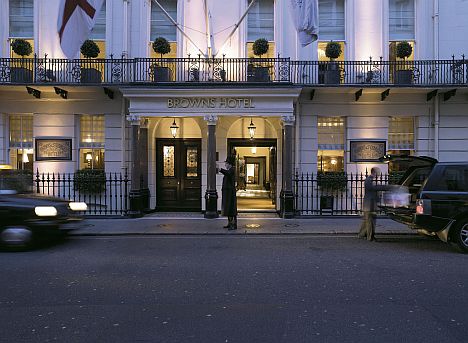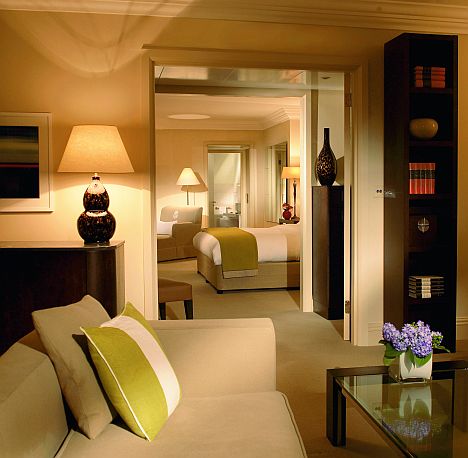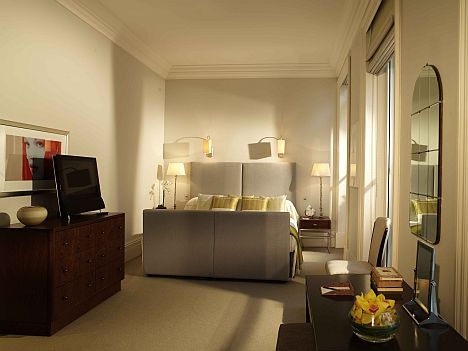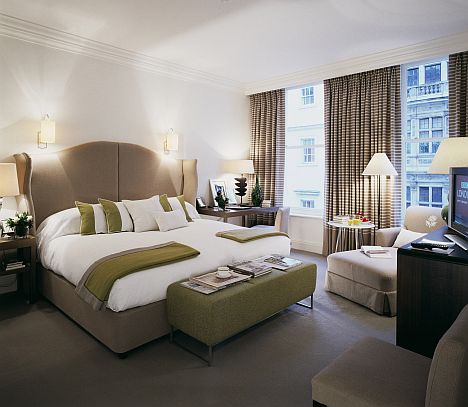
Review, history and photos of the Rocco Forte Hote.
A history of Brown’s Hotel
The city of London is full of luxury hotels, but only a dozen or so are worthwhile staying at. One of the finest addresses is Brown’s Hotel London.
Brown’s Hotel London opened in 1837 in Albemarle Street, a peaceful 18th century street at the heart of today’s fashionable Mayfair district. Together with Claridge’s, it is one of London’s oldest operating hotels with one of the trade’s most exciting histories.
Named after the Duke of Albemarle, the street where Brown’s Hotel is located was built from 1683 onwards by a syndicate that also built Band Street and Dover Street. From its inception, Albemarle Street was associated with famous names.
Oscar Wilde was a member of the bohemian Albemarle Club, open to both men and women. It is where the Marquess of Queensberry left a note accusing Oscar Wilde of sodomy, which lead to Oscar Wilde’s downfall in a society in which homosexuality was still a crime. Oscar Wilde was later forced into exile and died in Paris at L’Hôtel (French article).

A Classic Suite. Photos © Brown’s Hotel, London. A Rocco Forte hotel.
Brown’s Hotel is associated not with Oscar Wilde, but Lord Byron, whose publisher, John Murray, used to work from Albemarle Street. More important for the hotel’s history, in 1837. Lord Byron’s butler, James Brown and his wife, Lady Byron’s maid, acquired 23 Dover Street. By 1838, they had expanded, owning four adjacent houses in Dover Street. They opened a hotel for the service of the nobility and the gentry. In 1859, James John Ford, the new owner of the Brown’s Hotel, extended it to include St. George’s Hotel on Albemarle Street, which backed on to the Dover Street property. James John Ford was a man from Wiltshire who made money in Oxford Street with his livery and stable business before buying Brown’s Hotel.
Among the early illustrious guests were, in 1871, after the Franco-Prussian War and the creation of the Third Republic in France, Napoleon III and Empress Eugenie. They were forced into exile and stayed at Brown’s Hotel for some time.
In 1876, Alexander Graham Bell stayed at Brown’s Hotel when he informed the government about his communication breakthrough invention: the telephone. During his stay, he made the first UK telephone call from Brown’s Hotel, calling Henry Ford’s household in Ravenscourt Park through the hotel owner’s private telegraph line.
In 1882, James Ford’s son, Henry took over the hotel management for the following 46 years. Henry Ford focused on creating a “private” hotel, a place offering privacy to notable guests who were able to enjoy homely comforts. In the late 1880s, he introduced a smoking room for gentlemen as well as the first ever hotel restaurant. Prior to this innovation, guests ate in their rooms or in one of the 16 licensed suites in which to dine.
Henry Ford was eager to offer his guests a state-of-the-art comfort. In 1884, electricity was installed with the help of an oil-driven generator in the basement. A year later, bathrooms were introduced in all rooms and advertised as a Brown’s novelty.

Lounge in the Kipling Suite. Rudyard Kipling wrote The Jungle Bookwhile staying at Brown’s Hotel. Photos © Brown’s Hotel, London. A Rocco Forte hotel.
Among the illustrious guests honoring the hotel in this period was Theodore Roosevelt. He stayed at Brown’s before his wedding with Edith Kermit Carow, which took place at St. George’s in Hanover Square. As an occupation, the future president of the United States simply stated “ranchman”. Eleanor Roosevelt mentions Brown’s Hotel in her autobiography The Lady of the White House where she lets readers know that, in 1905, on her honeymoon, they stayed at the royal suite “with a sitting room so large that I could not find anything that I put down.” At Brown’s Hotel, the Roosevelt Room on the first floor is named of the American president Theodore Roosevelt. A copy of the marriage certificate still hangs on its wall. It is one of six present-day meeting rooms with natural daylight, high ceilings, precious antiques and state-of-the-art technology.
Among the notables staying at the hotel is also Cecil Rhodes, after whom Rhodesia was named. He was a frequent guest. From 1886 to 1894, the Count de Paris, the Pretender to the French throne, lived at the hotel, where he held Court regularly in his suite.
When Ford acquired St George’s Hotel in 1889, he merged it with the existing properties to create one big hotel. He also added a fifth floor. Incidentally, St George’s Hotel is still present in the hotel logo, the stationary and the stained glass image in the former St George’s Bar, now known as The Donovan Bar.
In 1890, Lord Kelvin led the international Niagara Commission meeting at Brown’s Hotel, which led to the decision to use the water power to conduct electricity. At present, the Niagara Room is a meeting and wedding room for receptions for up to 120 people.
From 1892 to 1936, Rudyard Kipling was a frequent visitor to Brown’s Hotel. He honeymooned at the hotel with his American bride on his first visit to Brown’s. He found the hotel conducive to his creativity. It is here for instance that he wrote The Jungle Book. Guests can stay at the Kipling Suite (87sqm), which is part of the original suite occupied by the poet and where many other famous writers have also stayed. In 1936, he was found here face down on his desk, suffering from a perforated ulcer. He was brought to Middlesex Hospital where he died shortly after surgery. Not long before, the head porter – named Nice – had asked Kipling to sign a copy of his novel The Absent Minded Beggar. The author did so saying jokingly: “You take that home and lock it away until I am dead. It will be worth a lot of money then.”

The bedroom in the Kipling Suite. Photos © Brown’s Hotel, London. A Rocco Forte hotel.
The most famous 19th century regular guest to Brown’s Hotel was Queen Victoria who of course never stayed overnight because of its proximity to Buckingham Palace.
In the 20th century, Brown’s Hotel underwent several transformations. In 1905, Brown’s Hotel was enlarged and restructured thanks to the acquisition of thee additional townhouses. The hotel remained popular with royalty and nobility, especially in times of troubles such as during the First and the Second World. War.
From 1914 to 1918, Queen Elizabeth of Belgium resided at Brown’s Hotel with her family during the First World War.
The Hellenic Suite (101 sqm) is named in honor of King George II of the Hellenes, the hotel’s longest royal resident. He left Greece in 1924 after the establishment of the republic and remained in exile until 1935, when the Greek monarchy was restored. In the decade abroad, Brown’s Hotel became the official court of the Greek Royal family.
In 1936, Haile Selassi, Emperor of Ethiopia, found refuge at the hotel when the Italian dictator Mussolini invaded his country. Three years later, King Zog of Albania did the same. In 1941, the Dutch Government in exile declared war on Japan at Brown’s Hotel. The declaration soon afterwards led to the occupation of the Dutch East Indies.
After World War II, famous writers continued to stay at the London hotel. Agatha Christie visited it many times. She based her book At Bertram’s Hotel on Brown’s Hotel. In more recent years, Stephen King stayed at the Kipling Suite.
In 1968, Brown’s Hotel was purchased by Trust House Limited, which later became Forte plc. In 1996, Forte was taken over by Granada and sold one year later to Raffles. In July 2003, Sir Rocco Forte, the son of the previous Forte boss managed to get the property back and integrated it into the Rocco Forte Collection. In April 2004, it closed down for a £24 million renovation under the direction of Olga Polizzi, the Director of Design for Rocco Forte Hotels and Sir Rocco’s sister. The hotel re-opened in December 2005 with 117 elegant rooms – including 29 suites – with original wood paneling, mosaic floors, chandeliers, guilt mirrors and antique furnishings. Olga Polizzi’s style is one of classy understatement.
I first stayed at the hotel in 2003 before its renovation in what was then called Executive Room 220, just when it passed from the Raffles group to the dynamic Rocco Forte hotel company. In 2003, the Grill at Brown’s Hotel was the only hotel breakfast restaurant able to offer me a Rocquefort for breakfast. In 2008, I stayed in the renovated hotel in number 521, a Deluxe King Room. Brown’s Hotel would not discuss its current guests, but staying there in 2008, I spotted for instance the Italian coach of the English football team, Fabio Capello.
On my suggestion in 2008, the English Tea Room, serving an excellent Afternoon tea, switched from minor brands to Mariage Frères and introduced adequate strainers and other filter systems, amazingly still absent in several London hotels. [Added on April 15, 2012: Staying at Brown’s Hotel again, I realize that the hotel has switched to Jing teas].
 £
£
The entrance. Photos © Brown’s Hotel, London. A Rocco Forte hotel.

The bathroom in a suite. The suites offer “Rain Forrest” shower heads. Photos © Brown’s Hotel, London. A Rocco Forte hotel.

The bedroom in an Executive Room. Photos © Brown’s Hotel, London. A Rocco Forte hotel.

The Albemarle restaurant. Photos © Brown’s Hotel, London. A Rocco Forte hotel.